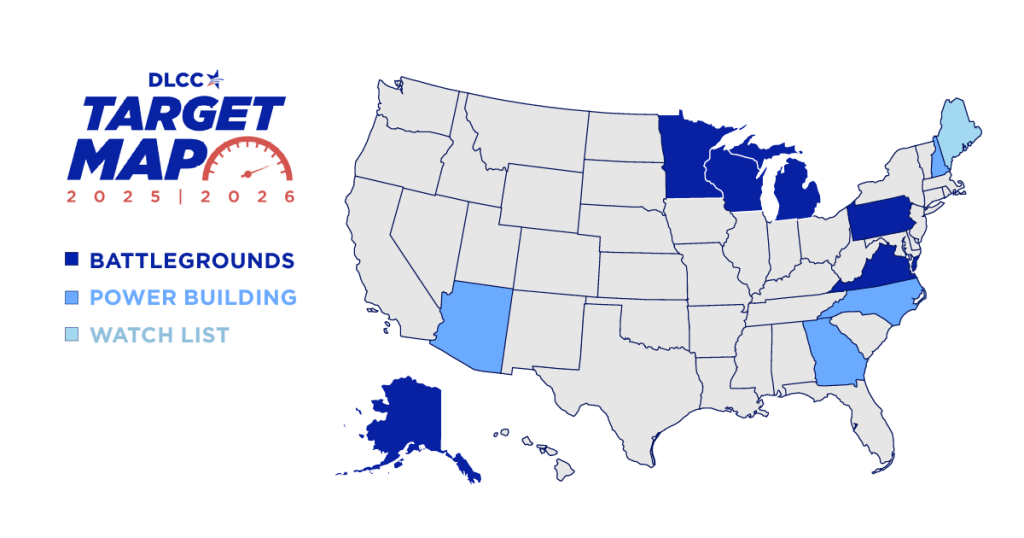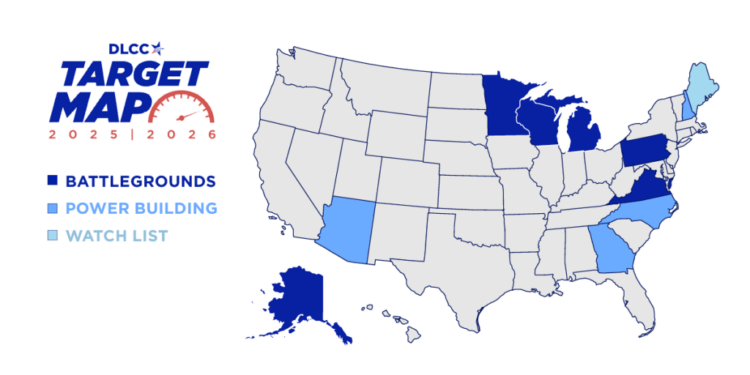At a time when Republicans control all levers of power in Washington and national Democrats are struggling to respond to Donald Trump’s increasingly extreme agenda, Democrats at the state legislative level are targeting ten states in an effort to resist Trump and protect key rights and freedoms.
The Democratic Legislative Campaign Committee (DLCC) announced this week that its top targets for the 2025-2026 election cycle include defending its one-seat majorities in the state Houses of Virginia and Pennsylvania, and both chambers of the legislature in Alaska, Michigan, Minnesota, and Wisconsin.
“Five of our battleground chambers were each decided in the last election cycle by a single seat, directly impacting the lives of 40 million Americans,” the DLCC wrote in a recent strategy memo. “Majorities in many states will likely come down to just a few districts and hundreds of votes.”
Democrats are also hoping to chip away at GOP state legislative majorities in Arizona, Georgia, New Hampshire, and North Carolina.

Such races are often overlooked at the national level, but state legislatures have a tremendous amount of power to decide weighty matters on the economy, healthcare, voting laws, abortion rights, gun control, and much more. The complete absence of Democratic power in Washington magnifies the importance of the states; Democratic attorneys general, for example, are leading the way on challenging Trump’s king-like assertion of executive power on issues like immigration and cuts to federal funding.
“As Trump throws one chaos bomb after another, there’s never been a more important time to watch what’s happening in the states,” DLCC President Heather Williams said in a press call on Friday. “State legislatures are the only ballot level with the power to fight back against Project 2025 and the Republicans’ takeover of Washington. This is also the only place where Democrats are in majorities and can pass any kind of proactive agenda.”
Democratic state legislative candidates outperformed the party’s dismal performance at the top of the ticket in 2024. Though Trump won 312 Electoral College votes, Republicans gained only 57 seats out of the roughly 6,000 races on the ballot across the country, according to an analysis by Bolts. While Democrats lost control of legislative chambers in Michigan and Minnesota, they held closely contested chambers like the Pennsylvania House and picked up 14 seats in the Wisconsin legislature after previously gerrymandered maps were struck down, rare bright spots for the party in swing states Trump won.
Still, following the 2024 election, Republicans have one-party control of 23 states compared to 15 for Democrats. Democrats want to not only pick up seats in 2026, but continue making gains through 2030, when new redistricting maps will be drawn following the decennial census.
The unpopularity of Joe Biden and Kamala Harris no doubt hurt Democrats down-ballot in 2024. In 2026, Democrats could benefit from an anti-Trump backlash at the polls, like they did during the first midterm election under Trump in 2018, when the party flipped more than 300 state legislative seats. Some of Trump’s initial actions in his second term, like a freeze on federal grants that states rely on, could be a particularly salient issue for voters. At the same time, local candidates may be better positioned to emphasize bread-and-butter issues like the cost of living that the national party too often ignored in 2024.
“I think by and large Democrats are focused on affordability,” said DLCC political director Jeremy Jansen. “One of the clear lessons learned from the electorate in 2024 is that affordability is a big issue right now. Democrats are doing what they can at the state level to impact the lives of everyday folks and help address issues of affordability and economic opportunity.”
The Republican advantage at the state level had a major impact on the balance of power in Washington. Republicans in North Carolina drew an aggressive gerrymander of U.S House districts in advance of the 2024 election, which allowed the GOP to pick up three new House seats—just enough to maintain control of the chamber and ensure one-party rule in DC, removing any checks and balances to Trump in Congress.
As Williams put it, “The future of the country hinges on the balance of power in the states.”







